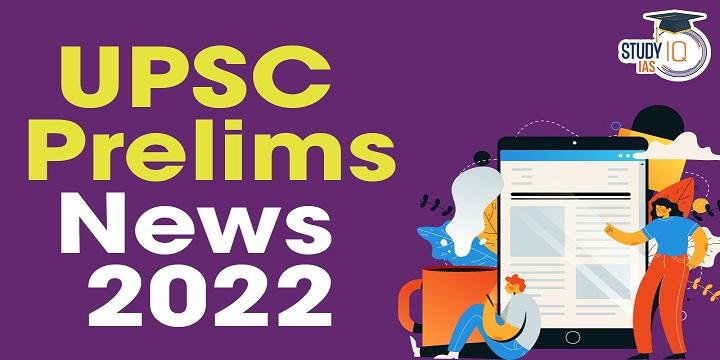UPSC Prelims News of 1 November 2022
Morbi Bridge
Context: The Morbi bridge collapsed in Gujarat.
About Morbi Bridge (popularly called the jhoolta pool)
- Built in 1887 during the reign of Waghaji Thakor, who ruled Morbi from 1870 to 1922, to connect Darbargadh (palace) and Nazarbaug over the Machchhu river.
- The bridge was built when Gujarat was part of the Bombay Presidency.
- Material for this bridge was imported from England and fabrication of the bridge was done by the Mumbai-based engineering company Richardson and Cruddas.
- The bridge was 765 feet long and about four feet wide.
- Unique Bridge: It was a suspension bridge — a type in which the deck is hung below suspension cables on vertical suspenders.
- Even the Howrah bridge in Kolkata or the Lakshman Jhula in Rishikesh are not suspended bridges, which makes the Morbi bridge very unique.
- The Golden Gate Bridge and Brooklyn Bridge in the US are examples of suspension bridges.
- India’s longest single-lane motorable suspension bridge — the 725-metre Dobra-Chanti suspension bridge built over the Tehri Lake — was inaugurated in November 2020.
UPSC Prelims News of 30 October 2022
Digital Rupee in Wholesale Segment (e₹-W)
Context: The Reserve Bank of India (RBI) commenced the pilot programme of Digital Rupee in the wholesale segment on November 1, 2022.
About the Digital Rupee in Wholesale Segment (e₹-W)
- The use case for this pilot is settlement of secondary market transactions in government securities.
- Significance:
- Use of e₹-W is expected to make the inter-bank market more efficient.
- Settlement in e₹-W would reduce transaction costs by pre- empting the need for settlement guarantee infrastructure or for collateral to mitigate settlement risk.
- Going forward, other wholesale transactions, and cross-border payments will be the focus of future pilots, based on the learnings from this pilot.
- Nine banks namely State Bank of India, Bank of Baroda, Union Bank of India, HDFC Bank, ICICI Bank, Kotak Mahindra Bank, Yes Bank, IDFC First Bank and HSBC have been identified for participation in the pilot.
What is Digital Rupee?
- The Central Bank Digital Currency (CBDC) can be defined as the legal tender issued by the Reserve Bank of India. Touted as Digital Rupee the RBI has proposed to issue two versions or e-Rupee, RBI’s CBDC.
- CBDC Vs e-RUPI
- The e-RUPI is a prepaid digital voucher and can be seen as similar to the CBDC, although it is not the same.
- The e-RUPI can be perceived as a step towards the CBDC.
- Types:
- The RBI has proposed to issue two versions of Digital Rupee — general purpose or retail (CBDC-R) and wholesale (CBDC-W).
- While retail CBDC is an electronic version of cash primarily meant for retail transactions, the wholesale CBDC is designed for the settlement of interbank transfers and related wholesale transactions.
HARIT Aaykar
Context: The Income Tax Department launched the HARIT Aaykar initiative on National Unity Day.
About the HARIT Aaykar initiative
- HARIT stands for Hariyali Achievement Resolution by Income Tax.
- Under this initiative, the Department resolves to increase the green cover by planting trees and creating micro-forests in and around Income Tax Department’s buildings and other public areas.
About the National Unity Day
- National Unity Day is celebrated every year on 31st October to commemorate the birth anniversary of Sardar Vallabhbhai Patel.
- It was celebrated for the first time in 2014. It is also known as Rashtriya Ekta Diwas.
- National Unity Day provides an opportunity to reaffirm the inherent strength and resilience of our nation to withstand the actual and potential threats to the unity, integrity and security of our country.
Income Tax in India
- Income tax is a direct tax which is imposed on the income of an Individual or Corporates.
- The first income tax was imposed in India in 1860 by Sir James Wilson.
- Income Tax Day is observed every year on 24 July.
- Income tax legislation in India
- When the Income Tax Act 1922 was introduced, it laid a proper framework for the direct tax administration in the country.
- After Independence the Income Tax act 1961 consolidated and replaced the 1922 Act.
- Applicability: It is applicable all over India. Sikkim was brought under the Income Tax act 1961 in 1989 and Jammu and Kashmir was brought under the act in 2019.
Curcumin Compound
Context: Researchers have found that curcumin compound can boost immunity in cattle to treat infectious diseases such as mastitis.
About Curcurmin
- Curcumin: Curcumin is a yellow pigment primarily found in turmeric. It is a polyphenol with anti-inflammatory properties and the capability to increase the amount of antioxidants that the body produces.
About the Research
- Curcumin increases immunity in cattle by increasing complementary protein, Interferon, Immunoglobulin (IgM), lymphocytes and monocytes.
- The study showed that there was a 1.42-fold increase in complementary protein C3 in the dry cows between 0 and 90th day.
- Calcium phosphorus ratio and albumin globulin ratio was higher in milch groups compared to dry and control animals.
- Significance: Increase in Calcium- Phosphorus and Albumin-Globulin ratio and digestibility index leads to 10 % increase in milk production.
- There was marginal increase in the SNF (solid non-fat) and fat content in milk after use of curcumin.
Mastitis:
- Mastitis is an inflammation of mammary gland. In cattle, the condition leads to inflammatory reaction of the udder tissue due to either physical trauma or infections caused by pathogens such as virus, bacteria or fungi.
- Symptoms: Swollen udders, lack of appetite, sunken eyes, digestive disorders and diarrhea, weight loss etc.
- Treatment: There is no vaccine available against mastitis. Anti-biotic treatment has proven effective.
- Losses: The economic loss due to mastitis in India is more than Rs 13000 Crores annually.
UPSC Prelims News of 2 November 2022





















 WhatsApp
WhatsApp